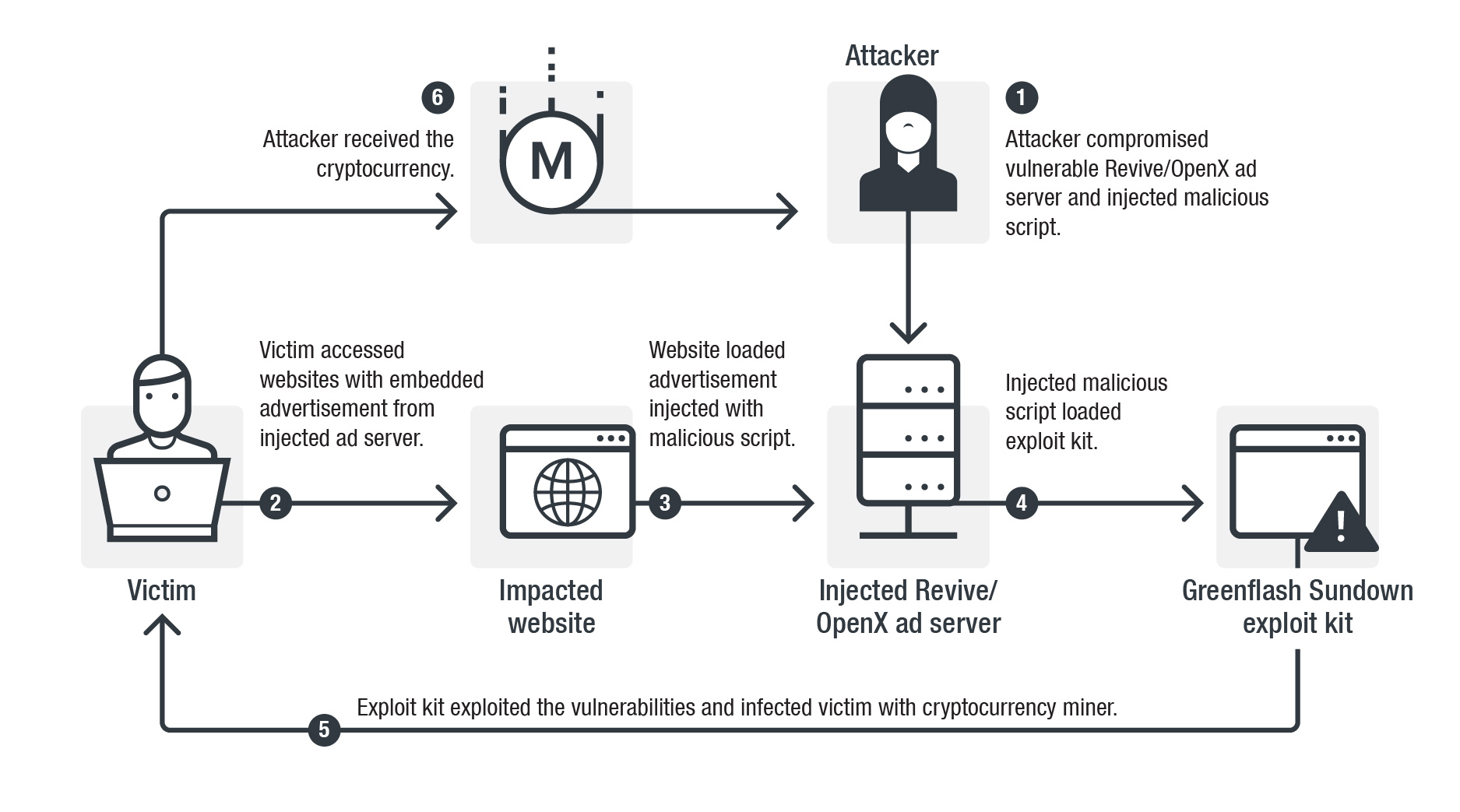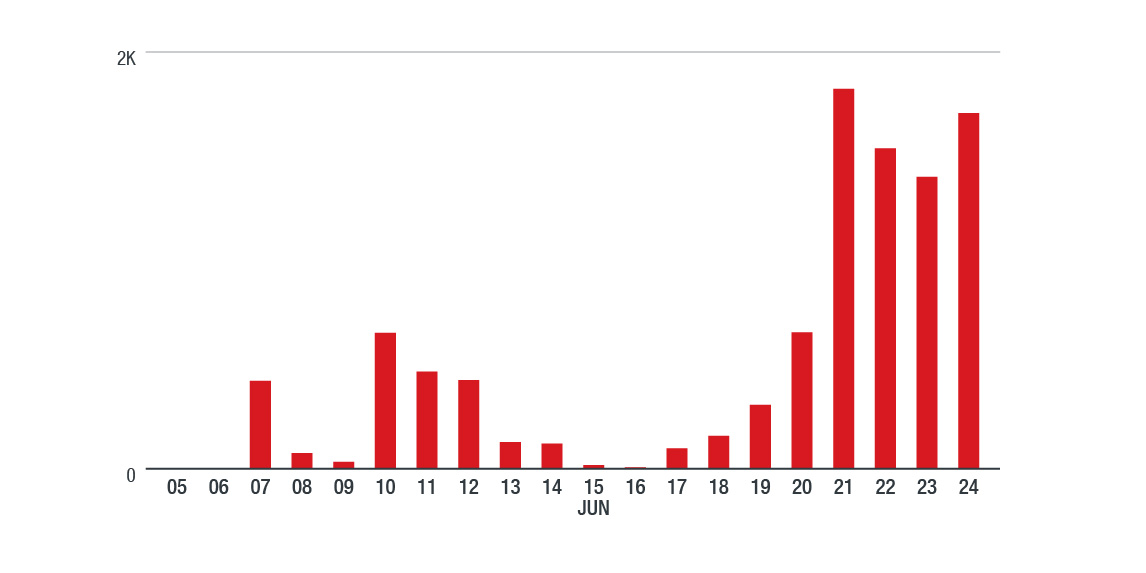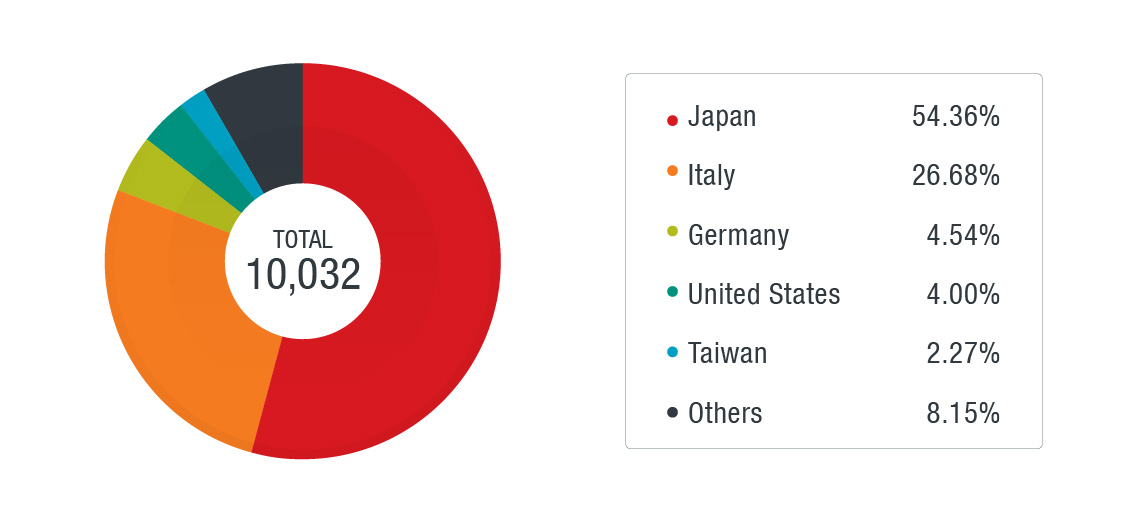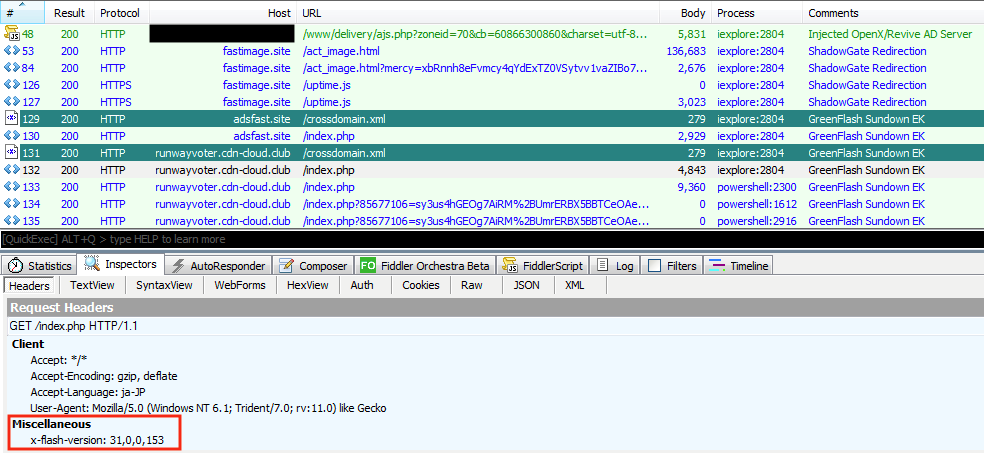Updated July 1, 4:20PM: Updated to clarify the product of Revive/OpenX that was compromised.
After almost two years of sporadic restricted activity, the ShadowGate campaign has started delivering cryptocurrency miners with a newly upgraded version of the Greenflash Sundown exploit kit. The campaign has been spotted targeting global victims, after operating mainly in Asia.
Background of the Greenflash Sundown exploit kit
The ShadowGate (also called WordsJS) campaign was identified in 2015. It delivered malware with exploit kits through the compromised ad servers of Revive/OpenX advertising software. After a takedown operation on September 2016, the campaign tried to hide their activities.
However, that same year they also developed their own exploit kit, which we named Greenflash Sundown, likely to avoid using exploit kit services from the underground market. At the end of 2016, the campaign stopped their injection attacks on the compromised ad servers and restricted their activity to spreading ransomware via compromised South Korean websites. In April 2018, ShadowGate was spotted spreading cryptocurrency miners with Greenflash Sundown. However, the injection was limited to servers in East Asian countries and soon stopped.
After a period of relatively restrained activities, we noticed ShadowGate attacking through ad servers again this June. However, these attacks were not just targeting regional victims but global ones. Visitors to websites embedded with malicious advertisements (from the compromised ad servers) were redirected to the Greenflash Sundown exploit kit and infected with a Monero cryptocurrency miner. This is the most notable activity we have seen from this group since 2016. Despite their low profile over the past couple of years, it seems that they have been continuously developing and evolving their exploit kit.
Below is a report on how the Greenflash Sundown exploit kit has changed since we discovered it in 2016, including details of their latest activity.
Greenflash Sundown refined evasion and targeting techniques
ShadowGate is invested in the continuous development of their exploit kit. In 2018, Greenflash Sundown was spotted integrating the Flash exploit for CVE-2018-4878 prior to other exploit kits. Greenflash Sundown was then identified using another Flash exploit for CVE-2018-15982 this April. The continuous updates of the kit to include new exploits allows it to maintain its infection rate.
Figure 1. Attack flow of ShadowGate and the Greenflash Sundown exploit kit
Figure 2. Timeline of ShadowGate Activity (data from Trend Micro Smart Protection Network)
Figure 3. Country distribution of ShadowGate Activity (data from Trend Micro Smart Protection Network from June 7, 2019 to June 24, 2019)
During the latest attack of ShadowGate that started this June, we found that they had another version of the Greenflash Sundown exploit kit with two updates.
Figure 4. Greenflash Sundown exploit kit traffic pattern (top) and exploits for CVE-2018-15982 (Flash version 31.0.0.153) (bottom)
The first change involves the integration of a public key encryption algorithm to protect their exploit kit payload. Last November, we saw that this exploit kit used the same encryption technique to protect their malware payload during the last infection stage. However, this time they used the encryption from the first few communications to encrypt all of their traffic during infection.
The encryption technique is as follows: first, the victim generates a random number called a nonce to produce a unique secret key during each attack. The secret key will be encrypted by a public key and then securely sent to the exploit kit. The exploit kit — using a private key — can recover the secret key and use it to encrypt the malicious payload that will be delivered with the RC4 algorithm (a cipher algorithm requiring a shared key for decryption). The payload will then be sent to the victim, who will decrypt it with the secret keys.
This encryption technique is supposed to prevent security solutions from detecting their malicious payload as it is transferred to the victim. In theory, because the secret key only exists in memory and is not supposed to be transferred directly in plaintext, it is difficult for a threat analyst to find the secret key and decrypt the malicious payload.
The use of public key encryption algorithm was also seen in the exploit kit Underminer, which we discovered last year. However, we found that the hackers behind the Greenflash Sundown exploit kit made a mistake with their encryption. They used the generated nonce not only for generating the secret key but also as a key of RC4 to encrypt victim’s WebGL information before sending it to exploit kit server. The generated nonce was actually sent in plaintext during their communication, which makes it accessible and readable. With the nonce, it becomes possible to reproduce the secret key and decrypt the malicious payload offline.
Figure 5. The Greenflash Sundown exploit kit encrypts the secret key with JSEncrypt library (deobfuscated)
The latest version of the Greenflash Sundown exploit kit also features an updated PowerShell loader. Since November 2018, we noticed the exploit kit started to use a PowerShell loader, which makes it capable of fileless malware infection. The upgraded loader in this new version is now capable of collecting a profile of the victim’s environment and sending the information to the exploit kit server.
This allows its operators to be more precise in their targeting. If the victim’s profile fits their specifications, the malware will deliver its payload. Otherwise, the server will return an empty response. The upgrade also helps them avoid sandboxes or honeypots that can capture their malware. The information taken from the victim includes OS details, user name, video card, hard disk information, and antivirus products.
Figure 6. The PowerShell loader sends victim’s profile and loads a malware payload with fileless infection
Recommendations and Solutions
Cybercriminals are continuously updating their exploit tools and techniques to evade detection and find better targets. These criminals sometimes spend years refining their attacks, as seen with Greenflash Sundown. To stay ahead of the curve, users should always keep their systems and applications updated to the latest version. The vulnerabilities targeted by these exploit kits usually have available fixes, so applying a solid patching and update strategy mitigates much of the risk. To further strengthen security, enterprises are also advised to enable a multilayered protection system that can actively block threats and malicious URLs from the gateway to the endpoint.
A proactive, multilayered approach to security is key against threats that exploit vulnerabilities. Trend Micro Deep Security also provides virtual patching that protects servers and endpoints from threats that abuse vulnerabilities in critical applications or websites.
Trend Micro customers are protected by the following Deep Security rule:
- 1009405-Adobe Flash Player Use After Free Vulnerability (CVE-2018-15982)
Endpoint security has vulnerability protection that shields endpoints from identified and unknown vulnerability exploits even before patches are even deployed. Trend Micro™ Smart Protection Suites and Worry-Free™ Business Security protect end users and businesses from these threats by detecting and blocking malicious files and all related malicious URLs.
This was also earlier reported by Malwarebytes.
Indicators of Compromise
| Indicator | Detection | File name |
| fastimage[.]site | ShadowGate/WordsJS malicious domain | |
| ad4989[.]world | ShadowGate/WordsJS malicious domain | |
| adsfast[.]site | GreenFlash Sundown EK domain | |
| adsfast[.]info | GreenFlash Sundown EK domain | |
| cdn-cloud[.]club | GreenFlash Sundown EK domain | |
| aeb073b5ee2e083aba987c7fcaab7265aabe6e5e2cade821db6d46e406e21e95 | Coinminer.Win32.MALXMR.SMBM4 | hp_3.exe |
| 58002d0b8acd1a539503d8ea02ff398e7ad079e0b856087f0ca30d767588be4e | Coinminer.Win64.TOOLXMR.SMA | hp_6.exe |







